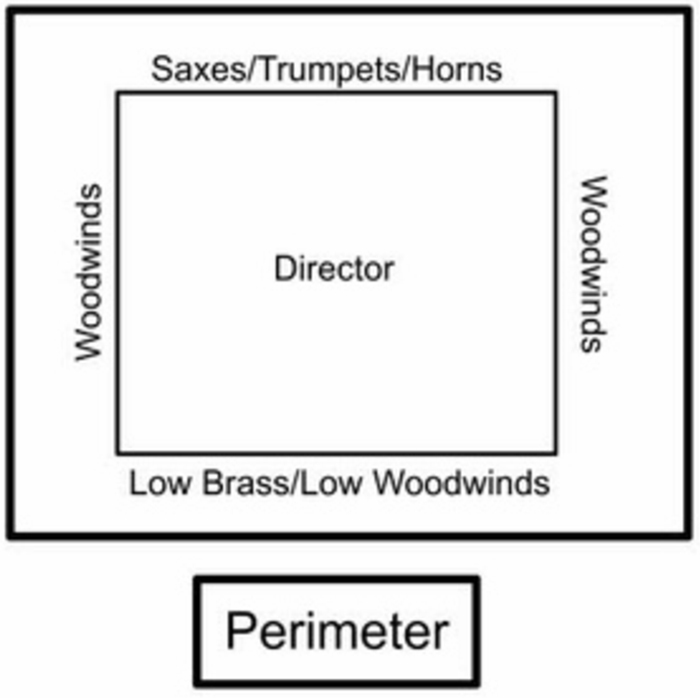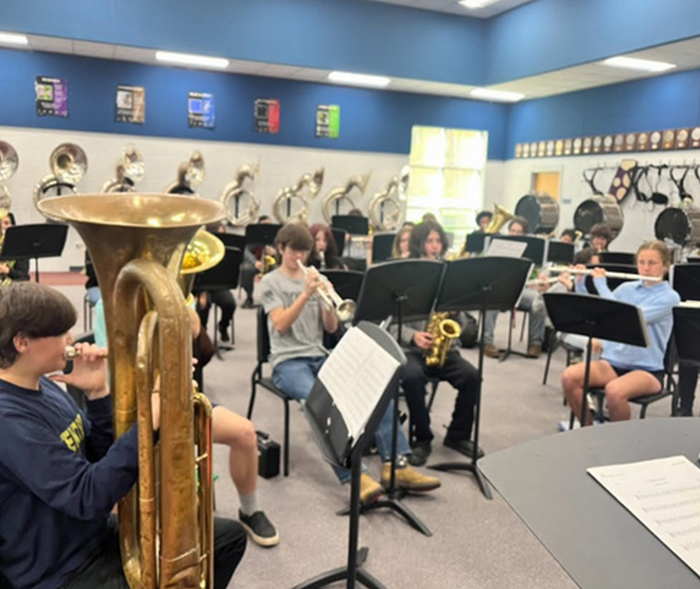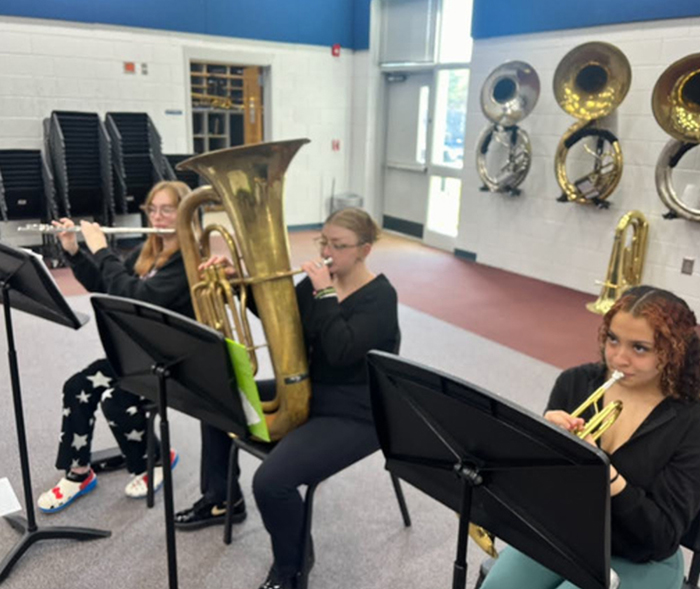Your cart is currently empty!
Thinking Outside The Arch
Alternative Seating For Concert Bands
by Jennifer Morse Weddington, WDBI High School Editor

It is easy for educators to fall into comfortable patterns as we navigate our normal day-to-day rehearsals. We become complacent with our warmups, our routines, and even our seating arrangements. In the band world, we have a common seating style that sets the band up for success during performances to create the optimum sound from the ensemble.
However, when it comes to day-to-day learning, it is acceptable to move away from what is comfortable and necessary for performances to something that may be more unique and beneficial to the students. When we think beyond the standard concert band arch and begin to use more varied seating arrangements in the classroom, we find that the students develop more advanced listening skills, the teaching is more effective, and overall it is just fun to mix it up from time to time. All of which leads to a more successful teaching and learning experience for all.
In our band room, we like to play with the seating arrangements from time to time. This keeps the students on their toes and offers them a different perspective from their traditional concert band arrangement. In the traditional seating arrangement, we typically have woodwinds in the front, horns/altos/trumpets in the middle, low brass/low woodwinds in the back, and percussion all over the place behind the horns. While this is necessary for optimal sound in a performance setting, this does not always create the best learning environment in the classroom and leads to classroom management issues or other learning problems for the students. When we think about alternative seating arrangements, the number of variations are as numerous as your imagination can create.
Seating Arrangement: Standard Concert Band Arch

In Image 1, I have a sample of how the students sit daily in my class with the standard concert band arch. For the majority of the time in class, we would sit in this seating arrangement and would always go back to it after using one of the alternative seating arrangements. The next several images provided in this article are samples of the various seating arrangements that we have tried. I have provided a very generic seating arrangement for each sample, but this would need to be altered based on your class and what the needs of the students are. In addition, none of the samples provided have percussion included as we have our percussion and winds separated. However, I advise you to add percussion and be creative with their placement as you do with the winds.
Each seating arrangement has pros and cons, which will be different for each group and classroom discipline. Overall, with each arrangement the students gave me positive feedback, indicating that it was worth the time and effort to make this a frequent occurrence. The students shared with me that it helped them hear parts in the music they would not normally hear or pay attention to. They also indicated that it made them concentrate more if they did not have members from their section near them. Ultimately, this divergence from the normal concert arch can lead to better musicianship.
As you can imagine, their favorite arrangement was the day when I told them to sit where they wanted. Of course, they enjoyed being with their friends. However, be warned that with this seating arrangement your classroom management skills need to be solid. Frontload the conversation with your students, before you switch, about the necessity of focus during instruction in this new and exciting arrangement. As you teach your classes, I encourage you to keep an open mind and think outside the traditional seating arrangement to come up with something that works for you and your group. As always, feel free to reach out to me via email if you have questions or want to discuss what has worked with your groups.
Seating Arrangement #1: Instrument Pods:
This arrangement can be particularly useful when you are teaching new material or beginners. The students can hear their peers better as they are separated farther from the other sections in the band. The teacher can walk around freely in the class and do more one-on-one instruction as the students are spread out more than in the traditional arch.



Seating Arrangement #2: Inverted Concert Arch:
In this configuration, the low brass are in the front of the classroom. This allows the students to hear melodies they are not accustomed to hearing from the back of the room. My students appreciate the different perspectives this seating arrangement provides. It also helps to occasionally have different students in the front of the room so you can effectively assess them and provide feedback.



Seating Arrangement #3: Spiral
My colleague, Patrick Watkins, came up with this configuration. It was an effective way to have the students work on their listening skills and balance within the ensemble. You can keep likeinstruments together, or mix them up as we did on this day. The students in the center particularly enjoyed listening to the music in this arrangement.


Seating Arrangement #4: Arches Facing In
When students sit in this arrangement, they are playing toward each other. We used this as an opportunity to encourage them to listen across the room and to blend their sound with their peers. Anytime they sit in a different arrangement, it opens the door to conversations about the music and offers them a unique listening experience.



Seating Arrangement #5: Perimeter
This seating arrangement is one of my favorites as it allows me to look at all the students without anyone in front of them. I like to walk around the middle of the square or stand on the outside and look in. It just depends on the activity. On the day shown in this image, we allowed them to sit anywhere they wanted. I have also used this seating arrangement to play recordings of their performances and ask them to critique what they hear. It helps a lot when they can face each other for these types of conversations.



Seating Arrangement #6: Sit Where You Want Day
This one speaks for itself. Naturally, it is what the students would want to do on a daily basis if we let them. Every once in a while, it is ok to give them this opportunity as long as you lay out the expectations clearly. It can be interesting to see who they choose to sit beside.


(All images are courtesy of Jennifer Weddington and the
Alexander Central High School Symphonic Band)
Contributing Expert

Jennifer Morse Weddington is a National Board Certified Teacher. She earned her BA in Music Education at Berea College (KY) and Master of Music Education at the University of North Carolina in Greensboro. From 2006 -2019, she served as the Director of Bands for East Wilkes HS and East Wilkes MS. She now serves as the Associate Director of Bands at Alexander Central HS in Taylorsville, NC. During her tenure at East Wilkes, she established the marching program and developed the band program into a reputable place where students wanted to be. She is also president-elect of the North Carolina chapter of WBDI.